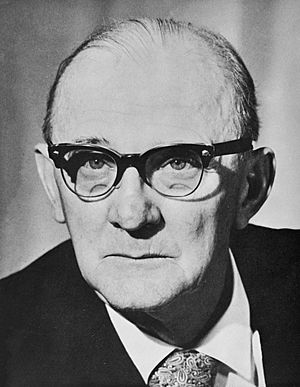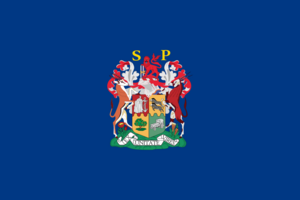State President of South Africa facts for kids
Quick facts for kids State President of the Republic of South Africa |
|
|---|---|

Standard of the State President (1984–1994)
|
|
| Style | The Honourable (until 1985) |
| Abbreviation | SP – the same abbreviation in both English (State President) and Afrikaans (Staatspresident) |
| Residence | Tuynhuys, Cape Town |
| Appointer | Parliament of South Africa as an electoral college – House of Assembly of South Africa and the Senate of South Africa meeting jointly for this purpose. |
| Term length | Seven years, nonrenewable (until 1984) Duration of Parliament (normally five years) (1984–94) |
| Precursor | Monarch of South Africa |
| Formation | 31 May 1961 (ceremonial) 3 September 1984 (executive) |
| First holder | Charles Robberts Swart |
| Final holder | Frederik Willem de Klerk |
| Abolished | 10 May 1994 |
| Succession | President of South Africa |
| Deputy | Vice State President of South Africa (1981–1984) |
The State President of the Republic of South Africa was the leader of South Africa from 1961 to 1994. This important job started when South Africa became a republic on 31 May 1961. Before this, the country was part of the Commonwealth of Nations, and Queen Elizabeth II was the Queen of South Africa. When South Africa became a republic, the role of the Governor-General of South Africa was removed.
From 1961 to 1984, the State President mostly had a symbolic role. This means they performed official duties but didn't make big decisions. However, after some changes in the law in 1984, the State President became the main leader. This person was then both the head of state and the head of government.
The State President was chosen by the Parliament of South Africa. This included both the Senate of South Africa and the House of Assembly of South Africa working together.
The job of State President ended in 1994. This happened when Apartheid ended, and South Africa moved to a new democratic system. Since then, the country's leader is simply called the President of South Africa.
Contents
The Ceremonial Role (1961–1984)
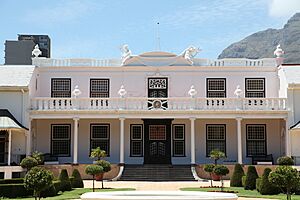
For a long time, the National Party, which was in power, wanted South Africa to be a republic. In 1960, they held a vote to ask people if they wanted to become a republic. A small majority of white voters, about 52 percent, voted yes. They wanted to stop having a monarchy.
The Republic of South Africa was officially created on 31 May 1961. Charles Robberts Swart, who was the last Governor-General, became the first State President. The name 'State President' was used before for leaders of the old Boer Republics. Like those leaders, the State President wore a special sash with the country's coat of arms.
The State President was chosen for a single seven-year term by the Parliament of South Africa. They could not be chosen again. The National Party decided that the State President would not have much power. This was to reassure English-speaking people who were against becoming a republic. So, the State President mainly did ceremonial tasks. They had to follow the advice of the Prime Minister and the cabinet.
In reality, the job of State President was often given to retired National Party ministers. This was similar to how the Governor-General's job had been since 1948. Because of this, all State Presidents from 1961 to 1984 were white, Afrikaner men who were over 60 years old.
The powers of the State President during this time were very similar to those of the Governor-General of South Africa.
The Executive Role (1984–1994)
In 1984, after new laws were passed, the State President's job changed. It became an executive role, meaning the person in this job had real power, like the President in the United States. The job of Prime Minister was removed, and its powers were given to the State President.
The State President was chosen by a special group of 88 members. These members came from the Tricameral Parliament, which had three parts:
- 50 white members
- 25 Coloured members
- 13 Indian members
These members were chosen by their own racial groups within the Tricameral Parliament. The State President held office for the length of the Parliament, which was usually five years. P. W. Botha, who was the last Prime Minister, became the first executive State President. He took over from Marais Viljoen, who was the last ceremonial State President.
The State President now had a lot of power. They were in charge of "national" matters, like how the country dealt with other countries and race relations. The State President also led the President's Council. This group helped solve disagreements between the three parts of Parliament about laws. The Council had 60 members. The State President directly chose 25 of these members.
Even though these changes were meant to share power, the way the electoral college and President's Council were set up meant that the white chamber almost always had the final say. This meant that real power stayed with white people. In practice, it stayed with the National Party, which had many members in the white chamber. Since Botha was the leader of the National Party, he held most of the government's power.
Botha stepped down in 1989. F. W. de Klerk took over from him. De Klerk then led the country through the big changes that ended white minority rule in 1994.
End of White Minority Rule
In 1994, South Africa adopted a new constitution. This constitution was for all races. Under this new system, the leader of the country is simply called the President. However, even before 1994, many countries outside South Africa already called the State President just "President."
Nelson Mandela, the leader of the African National Congress, became the first President of South Africa under the new constitution on 10 May 1994.
List of State Presidents of South Africa
- Political parties
National Party
- Symbols
and "acting" denotes acting president
| No. | Portrait | Name (Birth–Death) |
Term of office | Political party | Elected | |||
|---|---|---|---|---|---|---|---|---|
| Took office | Left office | Time in office | ||||||
| State presidents as head of state (Ceremonial, 1961–1984) | ||||||||
| 1 | 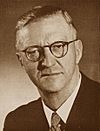 |
Charles Robberts Swart (1894–1982) |
31 May 1961 | 31 May 1967 | 6 years | National Party | 1961 | |
| — | 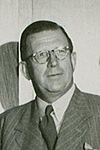 |
Theophilus Ebenhaezer Dönges (1898–1968) |
Elected, but did not take office because of illness | National Party | 1967 | |||
| — | 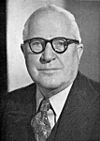 |
Jozua François Naudé (1889–1969) acting |
1 June 1967 | 10 April 1968 | 314 days | National Party | — | |
| 2 | 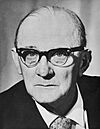 |
Jacobus Johannes Fouché (1898–1980) |
10 April 1968 | 9 April 1975 | 6 years, 364 days | National Party | 1968 | |
| — | 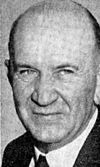 |
Johannes de Klerk (1903–1979) acting |
9 April 1975 | 19 April 1975 | 10 days | National Party | — | |
| 3 | 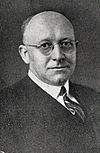 |
Nicolaas Johannes Diederichs (1903–1978) |
19 April 1975 | 21 August 1978 (died in office) |
3 years, 124 days | National Party | 1975 | |
| — | 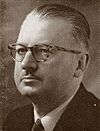 |
Marais Viljoen (1915–2007) acting |
21 August 1978 | 10 October 1978 | 50 days | National Party | — | |
| 4 | 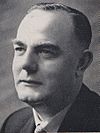 |
Balthazar Johannes Vorster (1915–1983) |
10 October 1978 | 4 June 1979 (resigned) |
237 days | National Party | 1978 | |
| — |  |
Marais Viljoen (1915–2007) |
4 June 1979 | 19 June 1979 | 15 days | National Party | – | |
| 5 | 19 June 1979 | 3 September 1984 | 5 years, 91 days | 1979 | ||||
| State presidents as head of state and government (Executive, 1984–1994) | ||||||||
| — | 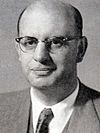 |
Pieter Willem Botha (1916–2006) |
3 September 1984 | 14 September 1984 | 11 days | National Party | – | |
| 1 | 14 September 1984 | 14 August 1989 (resigned) |
4 years, 334 days | 1984 | ||||
| — |  |
Jan Christiaan Heunis (1927–2006) acting |
19 January 1989 | 15 March 1989 | 55 days | National Party | – | |
| — | 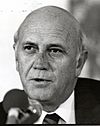 |
Frederik Willem de Klerk (1936–2021) |
14 August 1989 | 20 September 1989 | 37 days | National Party | – | |
| 2 | 20 September 1989 | 10 May 1994 | 4 years, 232 days | 1989 | ||||
Timeline of State Presidents

Related Topics
- State President of the South African Republic
- State President of the Orange Free State
- Governor-General of the Union of South Africa
- President of South Africa
- Prime Minister of South Africa
- Vice State President of South Africa


